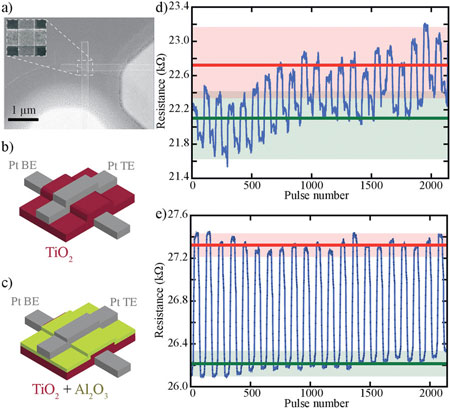| Posted: Jan 25, 2018 |
New technology standard could shape the future of electronics design
(Nanowerk News) Scientists at the University of Southampton have discovered a way of enhancing the capabilities of an emerging nanotechnology that could open the door to a new generation of electronics.
In a study published in the journal Scientific Reports ("Multibit memory operation of metal-oxide bi-layer memristors"), researchers show how they have pushed the memristor - a simpler and smaller alternative to the transistor, with the capability of altering its resistance and storing multiple memory states - to a new level of performance after experimenting with its component materials.
|
 |
| Comparison between TiO2-only devices and AlxOy/TiO2 bilayer devices. (a) SEM micrograph of a memristor device; (b) Schematic representation of a single layer TiO2-based device with platinum top and bottom electrodes; (c) Schematic representation of a bilayer AlxOy/TiO2-based device with platinum top and bottom electrodes; (d) Typical bipolar switching of a device based on the stack pictured in (b) using 100 ns pulses of alternating polarity voltage ramps ranging from 1 to 2 V, with voltage steps of 200 mV; (e) Typical bipolar switching of a device based on the stack pictured in (c) using 100 ns pulses of alternating polarity voltage ramps ranging from 1 to 2 V with voltage steps of 200 mV. The coloured horizontal lines in fig. (d) and (e) denote the average low (LRS) and high resistive state (HRS). (© NPG)
|
|
Traditionally, the processing of data in electronics has relied on integrated circuits (chips) featuring vast numbers of transistors - microscopic switches that control the flow of electrical current by turning it on or off.
|
|
Transistors have got smaller and smaller in order to meet the increasing demands of technology, but are now reaching their physical limit, with - for example - the processing chips that power smartphones containing an average of five billion transistors.
|
|
Memristors could hold the key to a new era in electronics, being both smaller and simpler in form than transistors, low-energy, and with the ability to retain data by 'remembering' the amount of charge that has passed through them - potentially resulting in computers that switch on and off instantly and never forget.
|
|
The University of Southampton team has demonstrated a new memristor technology that can store up to 128 discernible memory states per switch, almost four times more than previously reported.
|
|
In the study, they describe how they reached this level of performance by evaluating several configurations of functional oxide materials - the core component that gives the memristor its ability to alter its resistance.
|
|
Themis Prodromakis, Professor of Nanotechnology and EPSRC Fellow at the University of Southampton, said: "This is a really exciting discovery, with potentially enormous implications for modern electronics. By 2020 there are expected to be more than 200 billion interconnected devices within the Internet of Things framework - these will generate an incredible amount of data that will need processing.
|
|
"Memristors are a key enabling technology for next-generation chips, which need to be highly reconfigurable yet affordable, scalable and energy-efficient.
|
|
"We are thrilled to be working with world-leading industry, bringing innovations into new electronic systems that require bespoke customisation. Such examples include systems that are employed in inaccessible environments; for example, inside the human body, space or other remote or harsh locations.
|
|
"At the same time this technology is ideal for developing novel hardware that can learn and adapt autonomously, much like the human brain."
|

